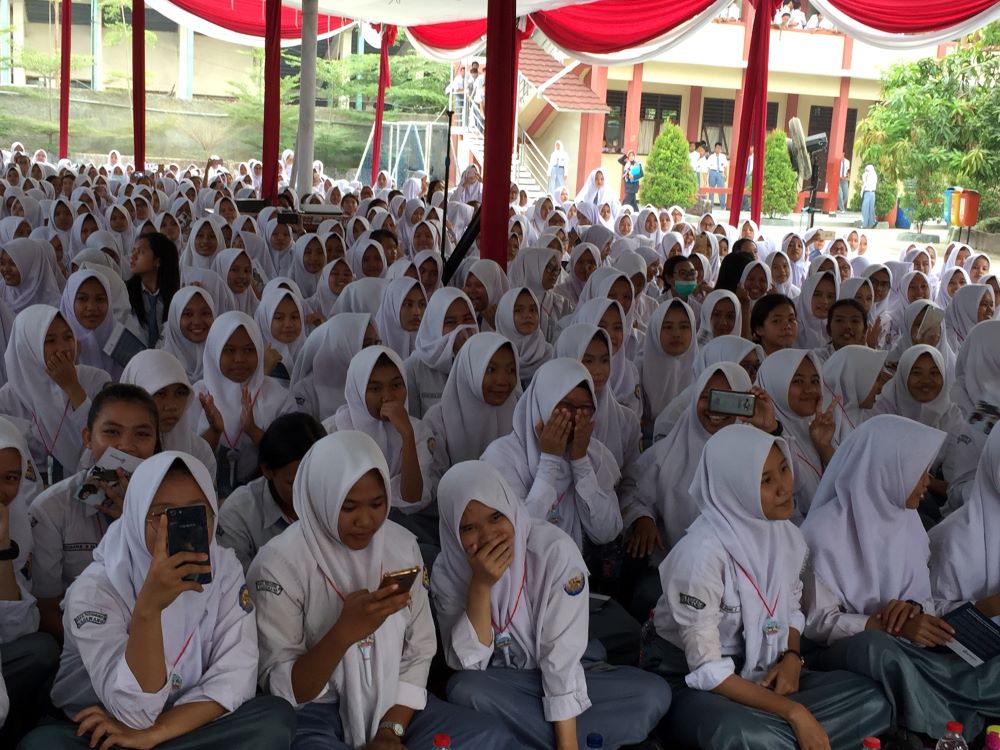Field Story
In her words: Voices from girls around the world
October 5, 2023
Adolescent girls in Indonesia use their smartphones to fight anaemia
Girls in Indonesia are using their smartphones to track their nutritional status and encouraging their friends to do the same.
Posted on November 22, 2019
By Radhika Srivastava, Regional Advocacy and Communications Manager, Asia

Ambar and her high school classmates are using their smartphones to fight anaemia. Not only do their phones keep them connected to their families and friends, they also help girls keep track of their own nutrition and encourage their friends to do so as well.
The level of anaemia among Indonesian adolescent girls, which is as high as 30 to 40% in some provinces, is a public health concern. In collaboration with the Government of Indonesia, Nutrition International supports a weekly iron and folic acid (WIFA) supplementation program, through which students of 8,913 schools receive nutrition education and an iron and folic acid (IFA) tablet every week.
The WIFA initiative has adolescents leading a number of activities, enhancing their leadership skills and making them full and active participants in a program meant to serve them. Several youth-led facets have been added to the overall design, including the use of social media for improved monitoring.
In Indonesia, 16- to 24-year-olds account for nearly half of the country’s internet users, with an average of five hours a day spent on smartphones.1 Taking advantage of the high internet connectivity among adolescents, high school students are turning to their phones to solve a problem: the lack of monitoring during school holidays.
When school is in session, monitoring is relatively easy. Teachers are trained to counsel the students and monitor the consumption of tablets. But when schools were shut down for periods in the summer and fall, and before exam periods, it was practically impossible to check IFA consumption among girls.
“We would provide the tablets in advance and hope that the students would consume them,” said Rizqya Giajeng Kartika, a teacher in the Banyuwangi district in East Java. “There was no way to monitor the consumption. We took it this would be a time when the program would go unmonitored,”
When the students became more involved in the program, they took the lead in devising a solution.
“We were given the responsibility to ensure all our friends take the WIFA tablets so we had to find a way to monitor the consumption during school holidays,” said high school student Revina.
“Since we would be in touch with our friends through social media during holidays, we decided to use WhatsApp as a platform to make sure all students were taking their tablet” said 16-year-old Ambar. “We created a WhatsApp group for every class where reminders for the weekly consumption would be sent.”
Reminders and responses on social media helped to encourage and monitor the consumption of the weekly IFA tablets. But just the reminders were not enough.
“We still didn’t know if the girls remembered to take the tablet,” said Revina.
What emerged was a proactive and fun addition to the WhatsApp-based monitoring.
“We asked all the girls to take a selfie just as they were about to consume the pill and post it on the group,” said Ambar. “This was liked by everyone and soon we started getting a lot of photos. The boys in the class played their part and posted appreciation messages on the group which further encouraged the girls.”
Seeing the involvement of all students in the WhatsApp groups, these platforms are now being used to share health and nutrition-related messages as well.
“We know that young people like us prefer to get information on their phones rather than a piece of paper,” said Ambar. “Besides, it is easy and quick to share and we can also have a discussion amongst ourselves without having to go to each other’s house.”
School teacher Retno Sulistyani, who is in charge of the WIFA program, values the use of technology to improve the nutrition of her students.
“We teachers are also benefitting from social media,” said Retno. “I often get nutrition-related messages from the puskesmas (community health center) on a WhatsApp group formed for school teachers. I easily share it in the groups formed for students.”
REFERENCES
1 Google survey 2018